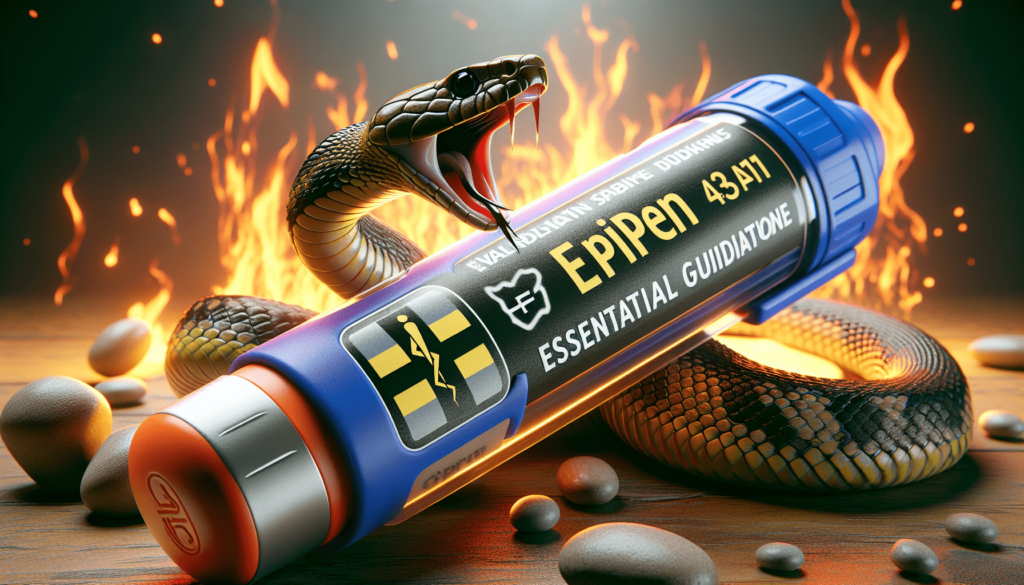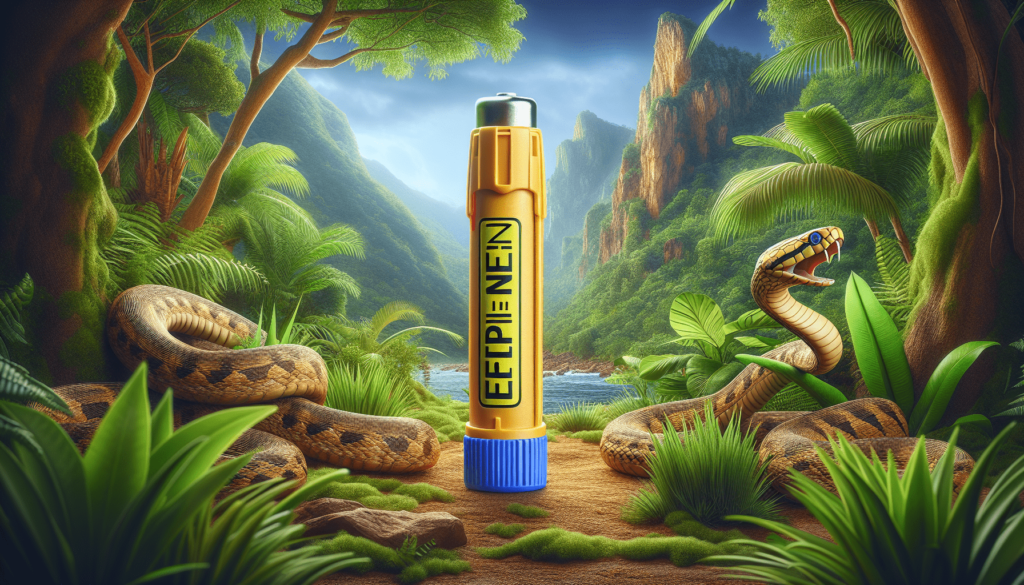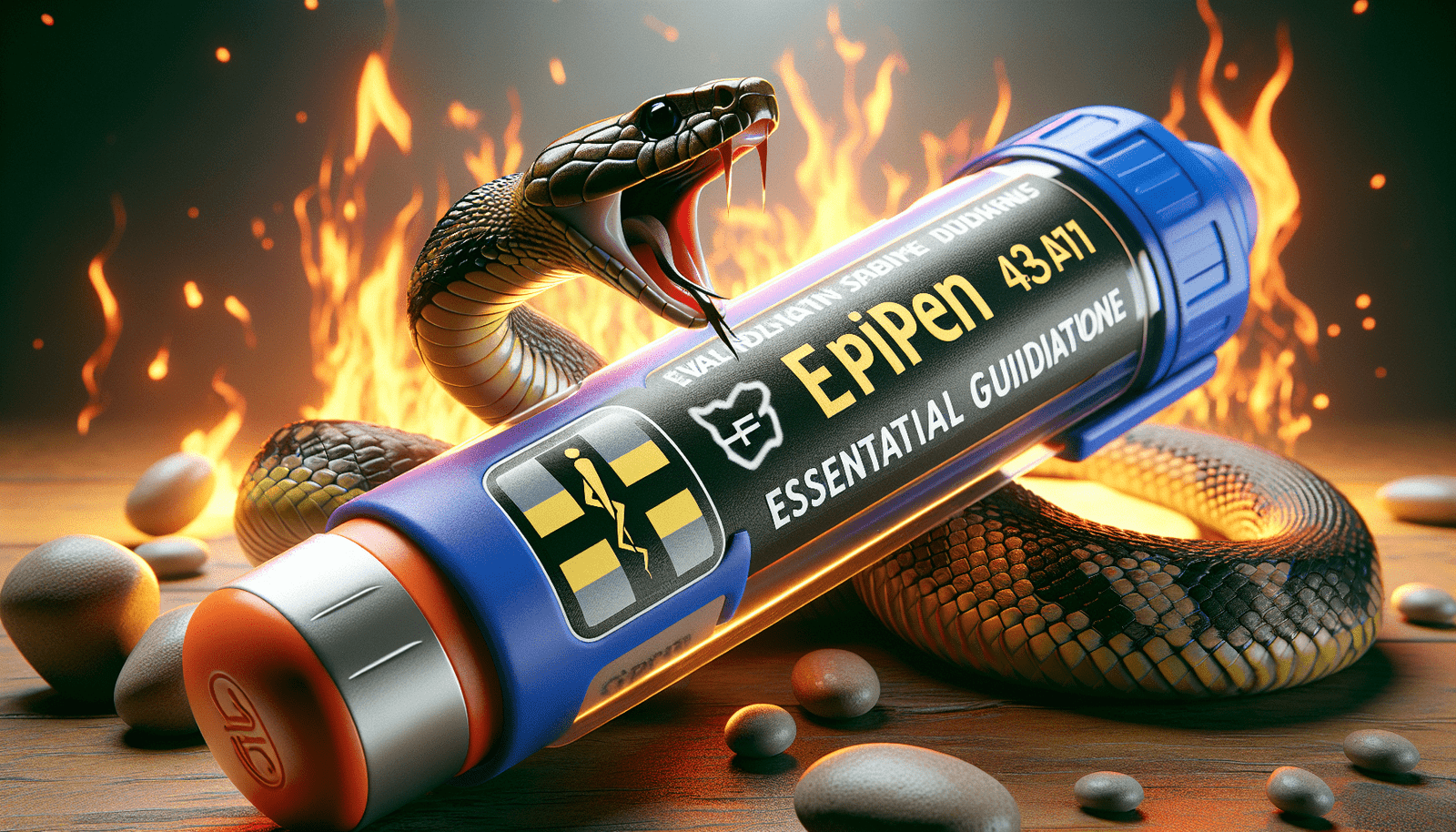Imagine embarking on an off-grid adventure, becoming self-sufficient and connecting with nature. In this journey, you learn valuable skills to handle unexpected situations and build resilience. From wilderness navigation to emergency medical knowledge, you delve deeper into self-sufficiency. Each lesson equips you with the confidence to tackle life’s unexpected turns. With this essential guide, you can learn how to react fast and save lives in the event of a snakebite. Explore the diverse topics in this guide and embrace the empowering freedom that comes with knowing how to thrive, no matter what life throws your way.
Understanding Snakebites
Snakebites can be a serious and potentially life-threatening situation. It is important to have a basic understanding of different types of venomous snakes, common symptoms of snakebites, risk factors, and how to identify snakebite wounds.
Different types of venomous snakes
There are numerous species of venomous snakes around the world. Some common types include rattlesnakes, copperheads, cottonmouths, and various types of cobras. Each snake has its own unique venom composition and characteristics, which can determine the severity of the snakebite.
Common symptoms of snakebites
When bitten by a venomous snake, it is crucial to be aware of common symptoms that may occur. These can include puncture wounds, swelling, pain, redness, bleeding, respiratory distress, nausea, vomiting, dizziness, and even organ failure in severe cases. It’s important to note that symptoms may vary depending on the type of snake and the amount of venom injected.
Risk factors for snakebites
There are certain risk factors that increase the likelihood of snakebites. These include living or spending time in areas where venomous snakes are found, such as forests, swamps, or grasslands. Additionally, engaging in outdoor activities without taking proper precautions, such as wearing protective clothing or not paying attention to surroundings, can also increase the risk.
Identifying snakebite wounds
When dealing with a snakebite, it is important to accurately identify the wound. Snakebite wounds may appear as two small puncture marks, which can help differentiate them from other types of wounds. However, not all snakebites will leave visible marks, especially if the snake had fangs that did not penetrate the skin. It is important to be cautious and seek medical attention regardless of the presence of visible wounds.
Prevention and Precautions
Taking preventative measures can significantly reduce the risk of snakebites. It is important to be proactive in protecting yourself and others from potential encounters with venomous snakes.
Wearing appropriate clothing and footwear
When spending time in areas where snakes are commonly found, it is important to wear long pants, boots, and thick socks to minimize the chance of a snakebite. Avoiding sandals or open-toed shoes is crucial as it leaves the feet vulnerable to snakebites.
Avoiding areas where snakes are commonly found
One of the most effective ways to prevent snakebites is by staying away from areas where venomous snakes are known to inhabit. This includes avoiding tall grass, thick vegetation, rocky crevices, and areas near water sources where snakes may seek shelter or prey.
Using snake repellents and traps
There are various snake repellents and traps available in the market that can help deter snakes from entering your property. These include chemical snake deterrents that emit strong scents, vibrating snake repellents, and traps that capture snakes alive for relocation. These methods can be effective in reducing the likelihood of encountering snakes.
Educating yourself and others about snakebite safety
An essential aspect of snakebite prevention is educating yourself and others about snakebite safety. This includes learning about the types of venomous snakes in your area, understanding their habitats, and sharing this knowledge with others. By raising awareness, you can help prevent snakebites and promote a safer environment for everyone.

Immediate Response to Snakebites
When someone is bitten by a venomous snake, it is crucial to respond quickly and appropriately. The following steps can help minimize the effects of the snakebite and increase the chances of a positive outcome.
Staying calm and assessing the situation
In any emergency situation, it is important to remain calm and assess the situation. Panicking can make it difficult to think clearly and take appropriate action. Stay calm and evaluate the severity of the snakebite and the condition of the victim.
Calling emergency services
Regardless of the severity of the snakebite, it is important to call emergency services as soon as possible. They can provide guidance over the phone and dispatch medical help if necessary. Time is of the essence when dealing with snakebites, and professional medical assistance is crucial.
Administering first aid techniques
While waiting for emergency services to arrive, you may administer basic first aid techniques. This includes keeping the affected limb immobilized, cleaning and disinfecting the wound, and elevating the injured area slightly if possible. However, it’s essential to avoid applying tourniquets or attempting to suck out the venom, as these methods can be dangerous and ineffective.
Applying pressure immobilization technique
If you are in a remote area and medical help will take an extended period to arrive, you may consider applying the pressure immobilization technique. This involves using a bandage or cloth to wrap the affected limb firmly, starting from the bite site and working towards the body. This method can help slow down the spread of venom while waiting for medical assistance.
First Aid for Snakebites
After the immediate response, proper first aid measures are essential for managing snakebites effectively. Adhering to the following steps can help minimize complications and promote faster healing.
Cleaning and disinfecting the wound
Once the victim has received medical attention, the snakebite wound should be cleaned and disinfected properly to reduce the risk of infection. Use clean water and mild soap or antiseptic solution to gently wash the area around the wound. Avoid scrubbing the wound excessively, as it can cause further damage.
Keeping the affected limb immobilized
To prevent further spread of venom, it is crucial to keep the affected limb immobilized. This can be achieved by splinting the limb using a rigid material, such as a piece of wood or cardboard, and securing it with bandages. Immobilization helps minimize movement and reduces the risk of venom spreading through the bloodstream.
Elevating the limb
Elevating the bitten limb can help reduce swelling. If possible, raise the injured arm or leg above the level of the heart. This can be done by propping the limb on pillows or using any available support. Elevating the limb should be done gently to avoid causing unnecessary pain or discomfort.
Applying ice or cold packs to reduce swelling
After immobilization and elevation, applying ice or cold packs to the snakebite area can help reduce swelling and alleviate pain. Wrap the ice or cold pack in a cloth or towel before applying it to the wound. Do not apply ice directly to the skin, as it can cause ice burn. Apply the cold compress for about 15 minutes at a time, with breaks in between.

Identifying Non-Venomous Snakebites
Not all snakebites are venomous, and it is important to be able to differentiate between venomous and non-venomous snakebites. This knowledge can help determine the necessary medical steps to take.
Characteristics of non-venomous snakebites
Non-venomous snakebites typically do not cause severe symptoms or complications. The wound may appear similar to a small puncture mark without extensive swelling or redness. Non-venomous snakebites are usually less painful and do not exhibit systemic symptoms like nausea or dizziness.
Differentiating venomous from non-venomous snakebites
Identifying the snake that caused the bite can help determine if it is venomous or non-venomous. If you are unsure about the snake’s identity, avoid trying to catch or handle it. Instead, take a clear photo or mental note of its characteristics and share this information with medical professionals.
Observing for symptoms of envenomation
Even if the snakebite is initially believed to be non-venomous, it is important to closely observe the victim for any signs of envenomation. Symptoms can develop over time and may differ depending on the snake species and the amount of venom injected. Seek medical attention immediately if symptoms worsen or new symptoms arise.
Seeking Medical Attention
Seeking prompt medical attention is crucial in managing snakebites effectively. Regardless of the severity of the snakebite, consulting healthcare professionals is essential for proper evaluation and treatment.
Importance of seeking medical help
Medical professionals are trained to handle snakebites and provide the necessary treatment. Even if the snakebite seems minor, healthcare professionals can assess the situation, administer appropriate treatments or provide further guidance. Delaying medical attention can result in complications and prolonged healing.
Transporting the victim safely
When transporting a snakebite victim to a medical facility, it is important to do so safely and efficiently. Keep the victim calm and still, and if possible, immobilize the limb again. Use appropriate transportation methods, such as a car or ambulance, and inform the medical facility in advance about the snakebite incident.
Providing accurate information to healthcare professionals
When seeking medical attention, provide accurate information about the snakebite incident. Be prepared to share details about the snake’s appearance, the location of the bite, and any initial symptoms experienced. This information can help healthcare professionals determine the appropriate treatment plan.
Antivenom and other treatment options
For venomous snakebites, antivenom is the primary treatment method. Antivenom is a medication that neutralizes the effects of snake venom. Healthcare professionals will assess the severity of the snakebite and administer the appropriate antivenom dosage. Other treatment options may include pain management, antibiotics for infection prevention, and wound care.
Managing Snakebite Complications
Snakebites can sometimes lead to complications that require additional management and treatment. Being aware of these potential complications can help in early detection and appropriate intervention.
Allergic reactions and anaphylaxis
Some individuals may have an allergic reaction to snake venom, which can manifest as hives, difficulty breathing, swelling of the face or throat, and a rapid heartbeat. In severe cases, anaphylaxis can occur, which is a life-threatening allergic reaction. It is important to seek immediate medical attention if these symptoms develop.
Tetanus prevention and treatment
Snakebites can introduce bacteria into the body, increasing the risk of tetanus infection. Healthcare professionals may administer a tetanus vaccine or provide tetanus immunoglobulin to prevent infection. Proper wound care, such as cleaning and disinfecting, is essential in reducing the risk of tetanus.
Infections and wound care
Snakebites can result in infections if not properly treated. It is crucial to practice thorough wound care, including cleaning the wound with mild soap or antiseptic, and applying appropriate dressings. If the wound shows signs of infection, such as increased pain, redness, swelling, or discharge, seek medical attention promptly.
Long-term effects and rehabilitation
In some cases, snakebites can cause long-term effects, such as tissue damage, nerve damage, or psychological trauma. Rehabilitation programs, including physical therapy and psychological support, may be necessary to facilitate recovery and restore functioning. Follow-up appointments with healthcare professionals are crucial to monitor and address any long-term effects.
Snakebite First Aid Kit
Having a well-prepared snakebite first aid kit can be a valuable resource in managing snakebites effectively. The following items are essential to include in a snakebite first aid kit:
Essential items for a snakebite first aid kit
- Sterile dressings and bandages for wound care
- Antiseptic solution or wipes for cleaning the wound
- Elastic bandages or compression wraps for immobilization
- Cold packs or instant cold packs for reducing swelling
- Scissors or a knife for cutting clothing and bandages
- Tweezers for removing debris or stingers from the wound
Emergency contact information
Include emergency contact information in your snakebite first aid kit, including the local emergency services number and the contact information of nearby medical facilities. This ensures quick access to necessary resources during a snakebite incident.
Other useful tools and supplies
In addition to the above items, consider including a flashlight, a snakebite identification guide, a snakebite suction device, and a compact snakebite field guide in your kit. These tools and resources can provide additional assistance when dealing with snakebites.
Snakebite Prevention for Outdoor Enthusiasts
For outdoor enthusiasts engaging in activities like hiking, camping, or hunting, it is important to take specific snakebite prevention measures. These can help minimize the risk of snake encounters and potential bites.
Safety measures for hikers, campers, and hunters
When engaging in outdoor activities, it is crucial to stay on designated paths and avoid wandering into snake habitats. Wear protective clothing, such as long pants and boots, and use insect repellent to minimize exposure to snakes and other pests. Always stay alert and watch where you step or reach to avoid accidentally startling a snake.
Tips for snakebite prevention during outdoor activities
- Make noise while walking to alert snakes of your presence.
- Avoid placing hands or feet in areas that are not clearly visible.
- Do not disturb snake habitats, such as rock piles or fallen logs.
- Keep campsites clean and free of food scraps, as they can attract snakes and other wildlife.
Carrying snakebite kits in wilderness expeditions
For wilderness expeditions or remote areas where immediate medical help may not be readily available, it is advisable to carry snakebite kits. These kits should include appropriate first aid supplies, snakebite identification guides, and communication devices to seek assistance if needed.
Navigating snake-infested areas
In areas known to be heavily populated with snakes, take extra precautions. If possible, consult local authorities or wildlife organizations for guidance on avoiding snake-infested areas, or consider rescheduling your plans to prevent unnecessary risks.
Snakebite Awareness and Education
To further promote snakebite safety, it is important to raise awareness and educate others about the risks and proper prevention and response techniques.
Promoting snakebite awareness in local communities
Organize community events or workshops focused on snakebite awareness. These events can include educational presentations, hands-on demonstrations of first aid techniques, and discussions on snakebite prevention. Engaging the local community can help spread crucial knowledge and foster a safer environment.
Educational programs and resources
Develop educational programs tailored to different age groups, such as schools, scout troops, or outdoor enthusiast organizations. Provide resources like brochures, pamphlets, and online guides that outline snakebite prevention strategies and first aid techniques. Make these resources easily accessible to reach a wider audience.
Collaboration with local authorities and wildlife organizations
Connect with local authorities, wildlife organizations, and healthcare professionals to create partnerships focused on snakebite prevention and response. Collaborating with these stakeholders can lead to more comprehensive and effective initiatives within the community.
Raising public understanding and safety
Advocate for policies or regulations that prioritize public safety regarding snakebite prevention and response. Encourage land management practices that minimize snake habitats near residential areas or popular recreation spots. By raising public understanding and safety, communities can work together to reduce the risk of snakebites.
In conclusion, understanding snakebites and taking proactive measures for prevention, immediate response, first aid, and treatment is essential for dealing with this potentially dangerous situation. By being knowledgeable, prepared, and aware of the risks, we can all contribute to a safer environment and minimize the impact of snakebites on individuals and communities.

